 Hello, gentle readers! It’s time for the next installment in our monthly series of articles looking at the developers and publishers behind some of our favorite games. The aim here is for you readers to get a sense of the person, so the tone is more conversational than we usually use in interviews here at TouchArcade. it’s also not necessarily about the games themselves, either. Basically, we’ll kick off and see where the conversation takes us. This month, we’re speaking to Jonathan Schneider of Aggro Magnet Games, the developer behind Vigil RPG (Free), an excellent game from 2014 that flew under the radar of many players.
Hello, gentle readers! It’s time for the next installment in our monthly series of articles looking at the developers and publishers behind some of our favorite games. The aim here is for you readers to get a sense of the person, so the tone is more conversational than we usually use in interviews here at TouchArcade. it’s also not necessarily about the games themselves, either. Basically, we’ll kick off and see where the conversation takes us. This month, we’re speaking to Jonathan Schneider of Aggro Magnet Games, the developer behind Vigil RPG (Free), an excellent game from 2014 that flew under the radar of many players.
For this transcript, my words will be bolded, while Jon’s will be in regular text. And now, let’s get to the interview.
Introductions and Pizza Talk
 For any of our readers who may or may not know who you are, who are you, what are you about, and what are your favorite pizza toppings?
For any of our readers who may or may not know who you are, who are you, what are you about, and what are your favorite pizza toppings?
Hey everybody, this is Jon Schneider, I am a professional developer, although not a professional game developer. As we’ll get into, Vigil RPG, which is my one published iOS game, was totally a side/evening project that I was just doing in my free time. I’m a dad, I’ve got three kids, so that keeps me plenty busy. My favorite pizza toppings are pepperoni, sausage, and mushroom. Preferably a deep dish!
Oh, deep dish. Now that’s one that I haven’t heard from anyone yet. I’m glad you’re specifying the crust, because I feel too many people gloss over it.
Oh yes, if I can get the super deep stuff… well, I live three hours outside of Chicago, in Western Michigan, and those Chicago-style deep dishes, when I can get my hands on them, that’s my favorite stuff. The authentic ones.
Excellent.
On Backgrounds and Inspirations
So yeah, you put out Vigil, which was, I want to say, an underground game? But one that I enjoyed very much. You mentioned that you are a developer, but not a game developer as your day job. What kind of development do you do? What kind of stuff do you make?
Sure. I’m basically what the “cool kids" might call today a full-stack developer. I do web applications, so I’ve got my hands in all pieces of that, from doing the front-end to the middle-tier business layer. I’m also maintaining the database, and writing for that. So kind of the whole thing, from front to back. I’ve been doing it for a while really. I was very fortunate to grow up with two parents in the computer industry in the early days. My dad actually worked for IBM, so we had an IBM PC in the house from almost as early as they were available. I had that to play around with as a little kid.
Wow.
And my mom worked in software as well, so I had a nice early start in learning. I taught myself to program in BASIC at home, at about six years of age, and I’ve been programming off and on ever since.
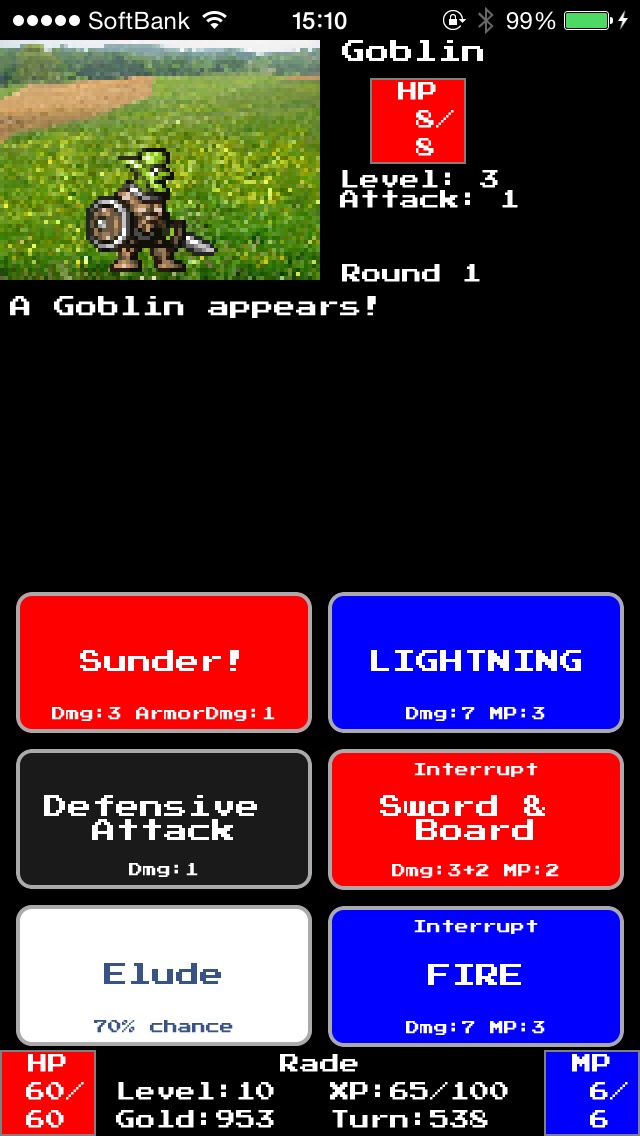 How did you go from that kind of work to deciding to make a game?
How did you go from that kind of work to deciding to make a game?
So I’ve done a number of programming projects on the side. This is the first game, but I’ve made a Windows Media Player skin which was open-sourced, I made an application for holiday and birthday gift-giving that my family uses internally… a number of things. Really, if anyone is interested they can hunt down my blog and I mention it a lot on there. Um, a common thing these days is when I’ve had the idea to write something, like a browser extension or some little tool that I feel like I need, I think that I could totally write that. But then I’ll think that I should probably see if someone has done it already, so I hit Google and search and, almost invariably, whatever idea I had, whatever I wanted, was out there already. So I just download what the other person made and get on with my day. It’s great.
Yeah.
In this case, though, I kind of had a hankering for a particular kind of game on a mobile platform, on the iPhone because that’s what I had in my pocket, that didn’t seem to exist. That was really surprising given the plethora, even back in 2013 when I first had this idea in my head, of RPGs that were available on the App Store. There just wasn’t one that I wanted. I had a checklist of things I was looking for. I wanted a turn-based, classic-style role-playing game, in the style of the original Dragon Warrior on the good old NES. That was my favorite role-playing game back as a kid, one of my early favorites.
I can tell! (laughing)
A lot of its influence obviously made its way into Vigil RPG. But just basically looking for a game with that turn-based gameplay and a single hero, so that you’re not trying to keep track of a whole party. Single, one-on-one battles. But then also the other major inspiration was, interestingly and oddly enough, the original Paper Mario that came out late in the life-cycle on the Nintendo 64.
Hunh.
And in that game, well, you might write it off as kind of a fluff RPG, like “oh look, someone put Mario in an RPG, ha ha, that’s really funny, there’s probably not that much depth to it", but actually, it’s my favorite combat system in any game that I’ve played. Because you could play it in such a smart way. Enemy hit points were visible, or at least you could pretty trivially make them become visible with an ability that you got right off the bat early in the game. And then every attack you had did damage not in the hundreds or thousands like your typical Final Fantasy game, but in the single digits. So if an enemy had five health, for example, you could go “well, I can do a normal attack for two, then spend a little of my flower points to hit them with a special for three" and really efficiently take them out using only one flower point. And you could extrapolate that. Paper Mario did feature multiple enemies at a time in battles, but it gave you that ability to really carefully and thoughtfully, again in a turn-based game with all the time you need to think about it, think through exactly how you could really efficiently beat this group of enemies and preserve your resources like your health points and your flower points.
Right.
So I kind of wanted to marry those two concepts. That really interesting gameplay in Paper Mario, that battle system, with an old school role-playing game like the old Dragon Warrior. I just couldn’t find that on the App Store, so I was like, “you know what? I bet I could write this myself". That’s what got me started.
That’s interesting. I mean, obviously I picked up on the Dragon Quest vibe, but I didn’t really notice the Paper Mario thing until you mentioned it, and that is… well, I can see it now.
On Developing Vigil
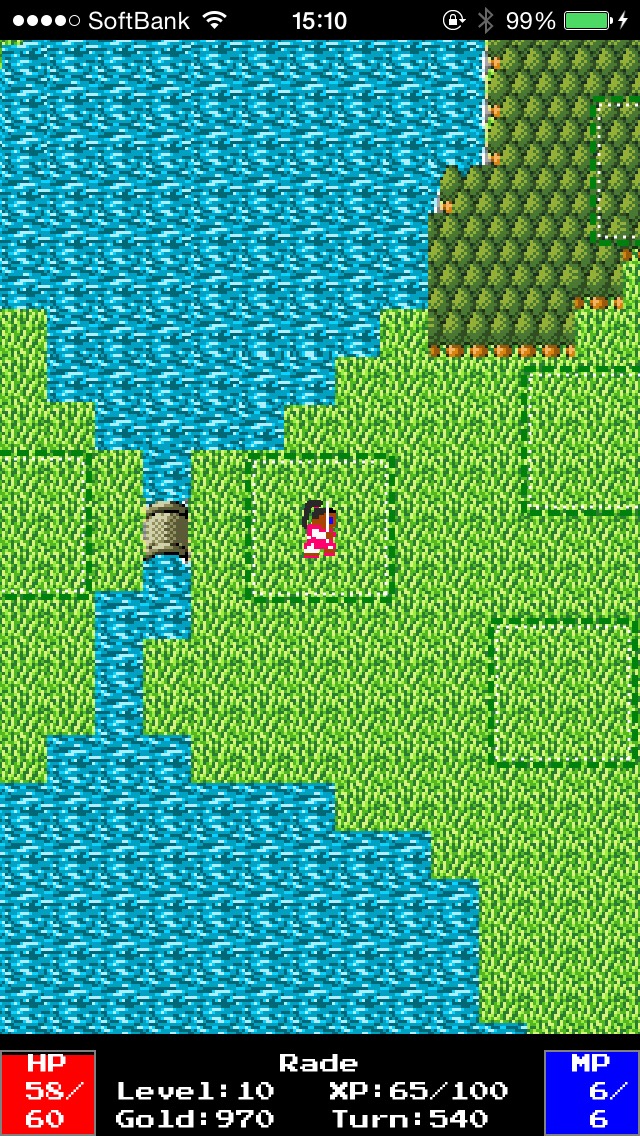 So was it difficult to make the game? Did you do everything by yourself? Is this a one-man show?
So was it difficult to make the game? Did you do everything by yourself? Is this a one-man show?
I’ll reveal a little secret. It was a total solo project, as far as I was the only developer on the project. I didn’t contract out any art or music or anything like that. It turns out… this is like a tip for aspiring or first-time game developers who don’t mind making a low-budget looking game as Vigil RPG certainly is, as you rightfully commented in your review back in 2014. Anyway, there are some sites which will provide you with art, music, and sound assets that are licensed for use in games, even commercial games like Vigil RPG is. Typically, with a Creative Commons license, which means as long as you give the creators credit, then you can go ahead and use that stuff in your game. I think one of the sites that I hit was Open Game Art, and there was just a number of pixel-art enemies in particular. For whatever talents I may have as a programmer, I’m just not an artist. I think I did art for one enemy in the game, the fire elemental, and even that was just a real picture of a flame that I scaled down and pixelated.
Okay.
Open Game Art was one, and there are a number of others. Right from the title screen of Vigil RPG, there’s a credits button you can hit so that you don’t have to wait until you finish the game or anything like that. If you just scroll through that, you’ll see the names of all the artists and musicians who, very generously, contributed these assets and just put them out there to use on an attribution basis. That was what really let me get the project off the ground, because if I had to try to draw the enemies myself, it just would have been really bad. Really awful. I mean, you can succeed doing that kind of thing. I don’t know if you’ve played Dream Quest, which is a game with a really interesting battle system but really crudely hand-drawn art. I think it manages to succeed in spite of the art, but I wanted to make the game look at least half-way nice. And of course, that 8-bit aesthetic, which is reasonably popular these days, is a way that I could pull it off, or to make at least a half-way polished-looking game without having it look awful in the process.
It’s interesting that you mention Dream Quest, because that’s actually going to be next week’s Reload article.
Oh, no way! Interesting. I’ll have to check out that article.
Yeah. The whole programmer art phenomenon. (laughs) But you know, it’s interesting because some developers have kind of made that their aesthetic. I think of, like, Michael Brough, who made 868-HACK and Imbroglio. You know, that is definitely “programmer art", but somehow it has become so distinctive to him that he’s made it work. Well, anyway. So how long did it take you start to finish on Vigil?
It took about eighteen months. That sounds longer than it really is. On the calendar, it was eighteen months, but it was really…. well, like I said, I have a day job, three kids, and a wife who I try to pay a lot of attention to and, you know, be a good dad and husband. So it was really me fitting it into my free time, which is roughly speaking between the hours of 10 PM and midnight. I would try to work two, three, four, sometimes five nights a week on it. I haven’t done the multiplication recently to figure out what that adds up to in terms of raw hours, but it was kind of just fitting in a couple of hours here and there whenever I could spare them, and when I wasn’t in the mood to, like, play other games.
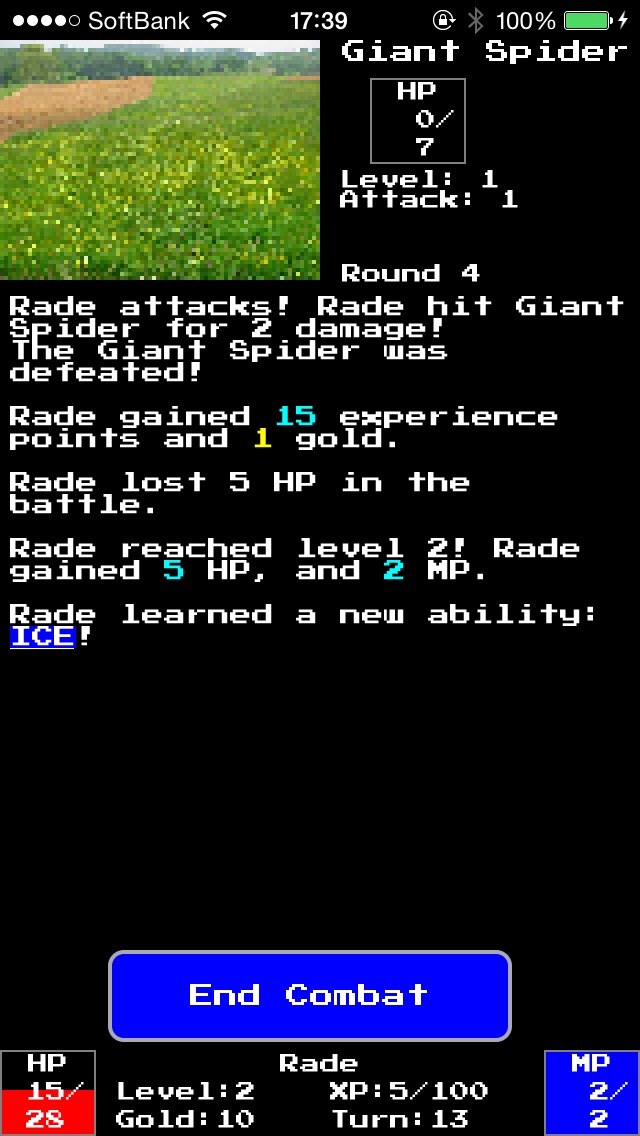 Did the final game end up matching what your concept was in the beginning? Was there anything you couldn’t do that you wanted to do? Any things that you are particularly happy about in the final product? I know that’s a lot of questions, but go for it.
Did the final game end up matching what your concept was in the beginning? Was there anything you couldn’t do that you wanted to do? Any things that you are particularly happy about in the final product? I know that’s a lot of questions, but go for it.
Yeah, so those are good questions. Um, there definitely are some things I had in mind that didn’t make it into the final game, like the way I started was to first open up some plain old text documents and start sketching out ideas. Like, what do I want the hero and her abilities to be like? What do I want the magic system to be like? What do I want the enemies to do? What do I want to do for a world map and for dungeons? What does the overall plot look like? And from there, I just went ahead and started implementing things. Let’s just kill something and see if it even works. See if I could even do it, technically, because this was my first… well, I’m actually a Windows guy, even though I carry an iPhone. I guess you could say I’m in both the Apple and the Microsoft worlds.
Right.
So this was my first project where I had to buy a cheap old Mac Mini off of eBay. Because I didn’t know if this was going to come to fruition, or if I was just going to go at it for a couple of weeks and realize that this wasn’t going to work and give up. I actually went ahead and invested, I think it was $450 to get a used, slow, old 2009 Mac Mini on eBay. It’s actually just sitting here on my desk right now, alongside my much nicer, more powerful Windows laptop that I have for work. I built Vigil on that. So the first thing I implemented, I think, was the combat screen, putting buttons on there so the hero could attack, displayed the enemy’s picture and stats, how much damage the enemy would do, and of course the box in the middle where the combat text was displayed.
Go on.
That was one thing from Dragon Warrior that I really wanted, to have the combat results in text so that it could be quick. Everything in Vigil RPG is controlled by one tap, you just have the single hero that you have to worry about, and you’ve got up to six action buttons in front of you, so that you just tap one of those to use it. One tap and the round plays out, and then you can see the enemy’s actions happen, you see your actions happen, and it’s just text with maybe a little graphical animation. So after around one second, the round has played out, you see what happened, and you can go on to the next round. Once you know what you’re doing, you can move through combat really quickly so that it never feels like a grind.
Yeah, it’s nice and fast.
Now, to answer your question about what didn’t make it. There were a number of ideas that I learned as I was doing this incremental process of building the combat screen, then building the world map, then building the town, and so on. Every time I built something, I would play with it for a little while and test it, see what worked and what didn’t seem to work. For combat, for example, I originally had the idea of making it a classic RPG in the sense of having a dodge chance on some of the enemies, where your attack would just randomly miss. Or a critical chance, where you would randomly do extra damage to the enemy or they would do extra damage to you. After play-testing, I just got rid of it. It didn’t seem to be necessary to have those systems in the game to add to the fun. It just added randomness. Vigil RPG is, ideally, so tightly-tuned that once you know what an enemy does and know how to counter its moves, you can defeat the enemy with very minimal expenditure of your resources. If enemy randomly dodges you sometimes, then suddenly whacks you an extra time for no reason, you’re just out a bunch of hit points.
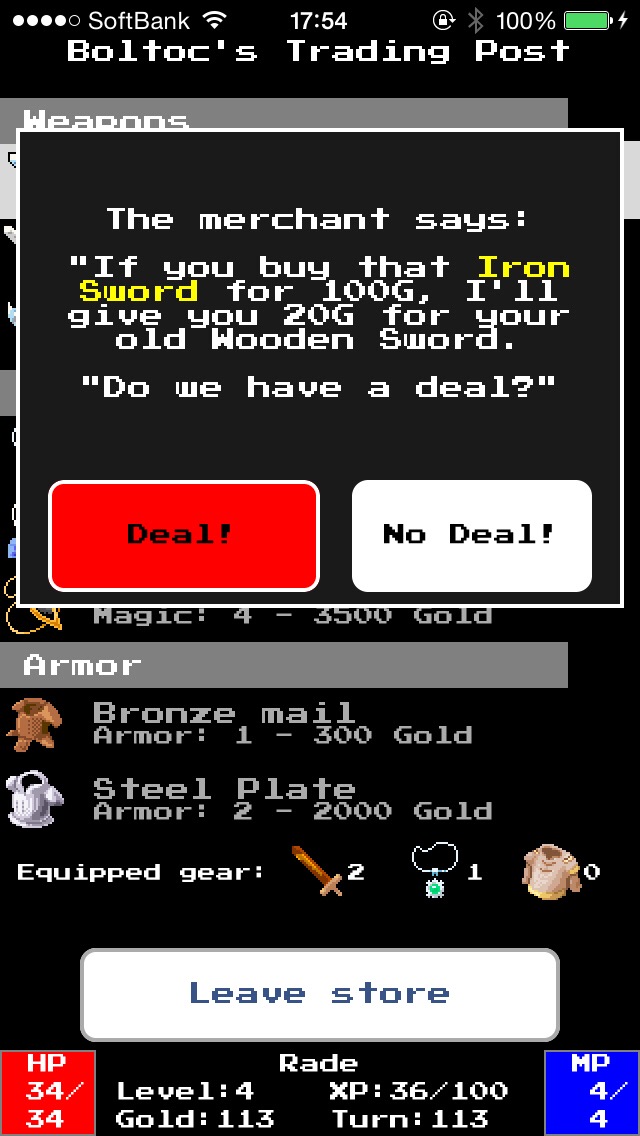 And it’s not your fault.
And it’s not your fault.
So I’ve recently noticed a bunch of games going with that model, which I think is interesting. Like, for example, Fire Emblem Heroes, which Nintendo just released a week or two ago as we’re recording this, uses that same mechanic. Whereas the mainline games have that randomness, that chance of critical hits and misses. The new one I think is trying to reduce complexity, reduce randomness where it doesn’t need to be, and make it more of a pure strategy game. Where what you’re doing determines whether you succeed or fail, not a dice roll. So that ended up working well. I took the dodge percent out, I took critical hits out, and the game was more predictable and more fun.
Interesting.
Another thing, which I think might be unique to Vigil RPG, is that when you flee from a battle, it pushes you closer to town. On the world map and dungeons, you’re not moving around with a d-pad. That was something I did not want to have on iOS, I didn’t want to carry over the d-pad concept just because in every console game ever you move with a d-pad. In Vigil RPG, there are just locations on the map and dungeons where you can touch to move and your character goes there. You don’t have to fiddle around, worrying about if your finger is off center on the d-pad, making your character move where you don’t want them to move. You move by touch, and when you flee a battle, your character moves one space closer to town. In this game, you’re trying to do everything with as few moves as possible, and you get better rewards if you make fewer moves, because you’re playing more efficiently.
Yes, it’s kind of a characteristic of the game.
When I was play-testing, I realized that in my original system, where when you ran from battle the character just remained in place, you could just go on to the next square. So you could just reach a place far away on the world map, like a boss for example, by fleeing from every single battle. You could enter into battle, flee on the first turn, lose little or no health from it, and move to the next square on the map. Do that again and again until you reach the boss, and you’d end up with a 90% full tank of hit points and be able to take the boss down easily. Which kind of defeats the game’s mechanic of trying to efficiently play your way to the boss, and actually fight your way through battles without losing too much health so that you would be in better shape to defeat the boss.
That’s interesting, you pre-emptively cut off that exploit. That’s good thinking!
Yeah, there were a couple of things like that, that’s just one example. A couple of other things… originally I had it so you could just scroll, touch the screen and drag it to scroll the world map around, but it added complexity and I had to worry about what would happen if you scrolled the map way away from where your hero is, and had to put a way to re-center it so that you don’t get lost, and if there should be a fog of war clouding the parts of the map that you hadn’t revealed yet because you haven’t made it over there yet, and so on. So I thought, why don’t we just always keep the hero centered on the world map, and what you can see on the world map is what is on your phone’s screen, like a small distance away from your hero and that’s it. It didn’t take away anything from the fun, so I went with that.
I was going to ask you about how the combat seems to be focused around learning what the enemy tells are. I was going to ask about that, but now I can see how that kind of ties into your philosophy of reducing randomness, so…
Yeah, reducing randomness, and the Paper Mario inspiration. Like you could jump on a Koopa or hit it with your hammer, and if you did that, it exposed its soft underside, taking away all of its armor, and you could defeat it easily. In the same way in Vigil RPG, a lot of enemies will give you clues, more obvious with the early enemies in the game, to kind of get you used to the system. They get more subtle later on. I think the first goblin you meet, just a couple of squares away from town, will pop text that says something like “The Goblin moves forward threateningly", but he doesn’t actually attack you that turn. So the idea is that you should defend with your shield, because if you don’t, he clobbers you with his big special attack, doing lots of damage. Whereas if you defend, it doesn’t do much damage at all, and you can go on to defeat him without losing much health.
Alright. You’ve almost hit on every little point I was going to ask about. That was a very good explanation, very thorough.
On Vigil’s Reception
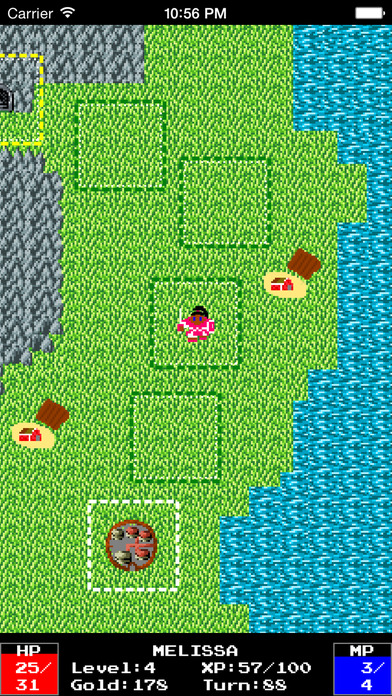 So I guess what I’ll ask about now is, how was your feeling about the game’s reception? You know, in terms of maybe from the players, from critics, and of course sales. Were you satisfied by it, were you surprised, or disappointed, or…?
So I guess what I’ll ask about now is, how was your feeling about the game’s reception? You know, in terms of maybe from the players, from critics, and of course sales. Were you satisfied by it, were you surprised, or disappointed, or…?
I was pleased. I mean, it was not a commercial success, but that was never the objective. I made a conscious design decision way back in the beginning, when I was sketching everything out in documents and deciding what I wanted the game to be. Even back in 2013, there was certainly the trend of all the big commercial successes using a freemium model, where you download the game and play for free, and the game tries to get you to make in-app purchases to cover the developer’s costs and make them some money. Players can try the game for free and see if they like it before they throw some money at it, which is great.
Alright, yeah.
But in my case, I wanted to go for the classic “pay up front and get it all" model, and the reason for that is that when I think about those free-to-play games, they’re kind of trying to serve two masters, or chase two goals. Number one is that they’re trying to make a fun game, obviously, but number two is that they’re trying to get the player to spend some money. Those two goals can be in conflict with each other. There’s nothing especially fun about having a stamina meter in your game, or having a premium currency that’s really hard to get your hands on. I guess it can be kind of fun to have that gacha-style random hero draw like in the new Fire Emblem game.
It can be, sure.
I guess I just didn’t want to have to try to serve the two masters, and just wanted to focus on making a fun game. You know, I didn’t want to make a fun game, and then try to take some of the fun away so that the player can get the fun back. I just didn’t want to go there. I’m fortunate enough to have a day job so that I can feed my family and live in a reasonable home, so I decided, you know what? I’m just going to put a reasonable price tag on it, like $2.99. You do that, you unlock the game, and you get the whole nine yards, and I can focus on making the game fun. Vigil RPG has got none of the trappings of those free-to-play RPGs. No stamina meters, no in-app purchases… it doesn’t even nag you for reviews, ever, because if it’s not fun, it’s not going in the game. And that was kind of the guiding philosophy.
Okay. So you mentioned it was not a financial success, but in terms of feedback from people, were you happy with what you heard?
I was, because to date the game hasn’t gotten a whole lot of attention, but what feedback there has been, has been almost universally positive. I think the game has yet to get a rating on the App Store that is not a five-star rating. Though there are only 15-20 reviews lifetime for the game, so that’s not saying much at all. But I was super-surprised and pleased to see your review, Shaun, of Vigil RPG when you did that back in November of 2014. Because, I’m totally not trying to flatter you or anything, but it was just spot-on and nailed what I was trying to do with the game. Just about everyone who has played the game has liked it. Some of the other forum communities I hang around in, as well as the TouchArcade community, has had lots of good things to say about the game. So even though the game only ended up selling a few hundred copies, and it’s only kind of just broken even, that’s fine. I’m just happy that those who have stumbled across the game and tried it seemed to have liked it.
On Future Plans
I guess my next question is, are you working on another game?
That’s a great question, and I was wondering if you would ask. Um, I’m not. As I mentioned, my time is really limited, so I like to try to spend it with my family first, and then those couple of hours to myself is when I play my games. I’ve got a number of things I’m playing right now, so I’m not actually working on a new game. What I do have part of the way done is an update to Vigil RPG itself to make it free, just so that more people can try it. Then there will be a one-time in-app purchase to unlock the rest, kind of like the model you would see a lot early in the App Store’s days.
 Right.
Right.
I’m going to, if I can get it to work well, try to flip Vigil over to that model, and… well, it’s not a money-making venture, really. I just think a lot of people would find the game fun and think it was cool, especially people who love old-school, NES-era role-playing games, or the Paper Mario combat system. If that sounds fun to them, a lot of people could get their hands on it for free. I plan on having a fairly generous portion of the game before that unlock point. I’m thinking of having it be a $2.99 unlock, kind of like how it was when I first released it. So if you want it for cheap, get Vigil RPG now. It’s $0.99 or your local equivalent, as cheap as Apple will allow me to price it without giving it away for free. If all goes well, in perhaps three or four months, you’ll see that big update that will make the game free. If you pick it up after that and want to see the rest of the game, you’ll have to pay the $2.99, buy me a coffee.
So people who bought the game will already be covered, right?
Absolutely. As you’d expect, if you paid, you’ll get the full version unlock right off the bat. You’ll just a get a big thumbs-up when you reach the place where you’d have to unlock.
Okay, just checking.
It’s the only right thing to do, I don’t want to make people pay twice.
On Inspirations Past and Present
So what kind of games do you like to play?
Um, one thing I’ve liked recently is Stardew Valley on PC, it’s fantastic. I had bounced off of a couple of the older Harvest Moon games. I tried them but I didn’t really like them. But Stardew Valley is a fantastic blend of relaxing farming and relationships with the townspeople. There’s kind of an efficiency aspect to that one too. I hadn’t realized this about myself or maybe why that’s why I like the game so much, but there’s definitely that in Stardew Valley. You have limited hours in the day, limited space on your farm, and so on. It’s up to you whether you want to optimize and get your farm going as well as you can with those limited resources. You have a limited stamina meter, too. I actually played through that game twice. I mean, there’s no real ending, but I played it until I had more money than I knew what to do with, the biggest house, a marriage, that sort of thing. So that’s been a lot of fun.
Anything else?
On iOS, I think my favorite game this past year was Solitairica, which I think had a nice review on TouchArcade. Again, it pushes a lot of those buttons I like. Turn-based strategy game, plays in portrait orientation, a limited number of skills at any given time (similar to Vigil), and just a lot of interesting strategic and tactical decisions with really balanced combat. It’s a lot of fun front to back. Then there’s Fire Emblem Heroes, it’s a riot. I’ve played, I think, every handheld US release of that series, and I’m enjoying a lot of the design decisions they made to fit that to the iOS platform. Then, in a completely different genre, there’s DOOM for PC. I’m finally digging into that one.
Oh, okay.
Perhaps as a throwback to some of the old DOOM games I played on PCs when I was a kid. I’ve noticed as an older gamer now, I’m pushing 40 soon, it’s hard for me to get into the AAA-type, full 3D graphics games where you run around in an open world. More so than it used to be for me. But I played DOOM enough that I stuck with it and the gameplay started to click. And it helps that the systems in that game are very similar to the old 1990s-era DOOM games. So I’m going through that game now and I’m enjoying it quite a bit. I got that game to exercise what is the first new home PC I’ve bought in eight years. So that’s giving that a work-out, and it’s enjoyable.
Nice!
I also managed to secure a pre-order for the new Switch, which is coming out in a few weeks. I’m looking forward to playing Zelda: Breath of the Wild on that hybrid console/handheld.
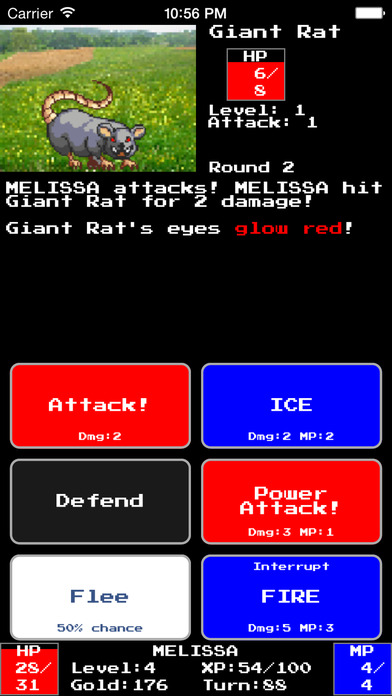 Okay, well, time just flies on this thing, but I guess we’re getting to the end of our allotted time here. If there’s anything you want to say now, any message you want to put out there, go for it.
Okay, well, time just flies on this thing, but I guess we’re getting to the end of our allotted time here. If there’s anything you want to say now, any message you want to put out there, go for it.
Um, just want to give a shout-out to my wife Melissa, who I love and who was super-patient with me as I disappeared many nights during 2013 and 2014 to work on Vigil RPG and get it out the door. It was something I always dreamed of doing, developing my own game, and I finally made it happen. Apart from that, I just want to thank all those art, music, and sound creators who, very unselfishly, put their talents up on the internet for use with Creative Commons or even just free licenses. You can check out all of those folks in the Vigil RPG credits, and I’d encourage everyone to just take a quick look at that, find those folks, and check out their other stuff, because they do really good work. Finally, one final shout-out to the Gamers With Jobs community. An awesome bunch of folks, so any mature gamers who are looking for good discussion and like-minded folks to play with, that’s a great place to hang out.
Alright, well, thanks a lot for your time! Even though you’re not making any new games right now, it’s good to talk to people even if they just did a one-off like you did. And who knows what the future might hold, right Jon?
Yeah, once again, if I have a hankering to make another game, you’ll be among the very first to know.
Great, thanks! And thanks for talking to us today!
Thanks again to Jon for agreeing to this interview and filling us in on his past, present, and future. Thanks also to you, kind readers, for supporting this idea. Remember, features like this one are only possible thanks to your generous support of the TouchArcade Patreon. If you enjoy these interviews, please consider subscribing to the Patreon to help us keep delivering them. If you have any developers you’re interested in hearing from, or if you are a developer interested in taking part in one of these interviews, please let me know in the comments below or by tweeting me at @RPGReload. As for me, I’ll be back next week with another article.
Next Week’s Reload: Dream Quest ($2.99)
